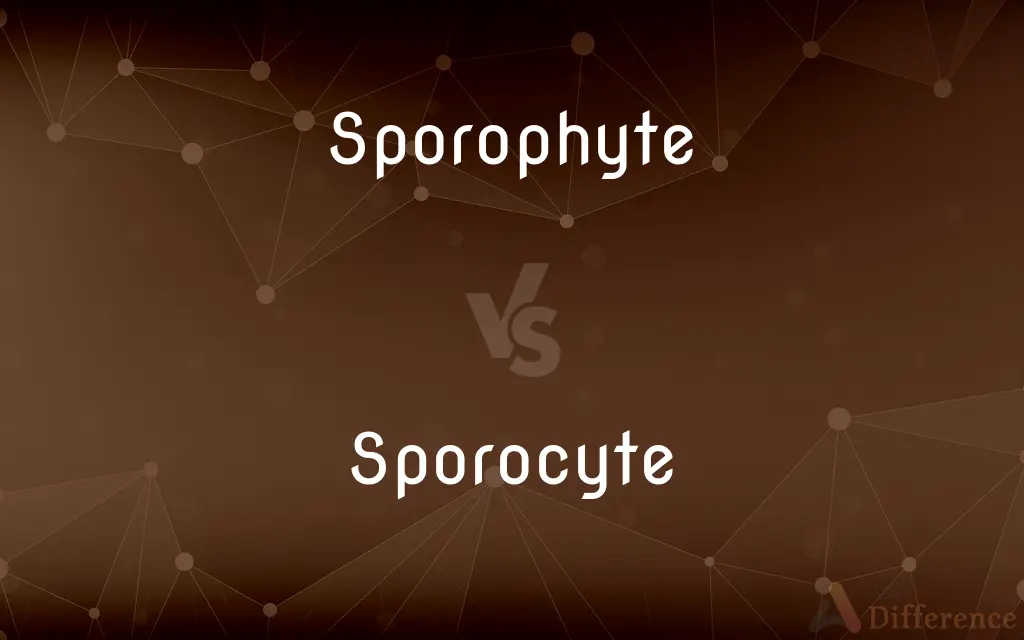Sporophyte vs. Sporocyte — What's the Difference?
By Maham Liaqat & Urooj Arif — Updated on April 21, 2024
A sporophyte is a multicellular organism in the life cycle of plants and algae that produces spores, while a sporocyte is a cell within the sporophyte that undergoes meiosis to generate spores.

Difference Between Sporophyte and Sporocyte
Table of Contents
ADVERTISEMENT
Key Differences
The sporophyte is one of the two major stages in the life cycles of plants and algae, specifically the diploid phase, which alternates with the haploid gametophyte phase. It is responsible for producing spores that will eventually grow into gametophytes. On the other hand, a sporocyte is a specialized cell found within the sporophyte. This cell is significant because it undergoes meiosis to produce haploid spores.
In terms of structure, the sporophyte can be a complex organism with stems, roots, and leaves, as seen in higher plants, or simpler in forms like algae and mosses. Whereas, sporocytes are individual cells, typically located in reproductive structures like the cones of gymnosperms or the capsules of mosses.
The role of the sporophyte in the plant life cycle is to continue the species by producing spores, which are the reproductive units that can give rise to new gametophytes. Conversely, the role of the sporocyte is more focused; it is to undergo meiosis, reducing the chromosome number by half, thus enabling the cycle of alternation between haploid and diploid stages.
The sporophyte often performs photosynthesis and contributes significantly to the plant's growth and development. In contrast, sporocytes are crucial for genetic diversity, as the meiotic process they undergo leads to genetic recombination and variation in the resulting spores.
Sporophytes can have roles beyond reproduction, contributing to their environment by stabilizing soil, producing oxygen, and serving as food and habitat for other organisms. Meanwhile, sporocytes are strictly reproductive and do not interact directly with the ecosystem outside of their role in spore formation.
ADVERTISEMENT
Comparison Chart
Definition
A multicellular diploid plant phase
A cell that undergoes meiosis to produce spores
Location
Throughout the plant
In reproductive structures
Function
Produces spores, photosynthesis, supports growth
Undergoes meiosis to produce spores
Complexity
Organism with multiple cells and structures
Single cell within the sporophyte
Role in Life Cycle
Alternates with gametophyte, produces spores
Produces genetically diverse spores
Compare with Definitions
Sporophyte
Produces spores through meiosis in structures called sporangia.
The pine tree, a sporophyte, develops cones that contain sporangia.
Sporocyte
A cell that undergoes meiosis to form spores in the sporophyte.
In mosses, sporocytes within the capsule undergo meiosis to produce spores.
Sporophyte
The diploid multicellular stage in the life cycle of plants and algae.
In ferns, the sporophyte is the dominant, leafy plant that we commonly see.
Sporocyte
Located in specific structures dedicated to reproduction.
Sporocytes are found in the sporangia of ferns.
Sporophyte
Essential for the reproductive cycle, ensuring the continuation of species.
After spores are released by the sporophyte, they can germinate into new gametophytes.
Sporocyte
Directly contributes to the alternation of generations.
The spores formed from sporocytes will develop into haploid gametophytes.
Sporophyte
Has a complex structure including roots, stems, and leaves in higher plants.
The large fronds of a fern represent the sporophyte stage.
Sporocyte
Essential for the plant's lifecycle progression.
Without sporocytes, the plant cannot complete its lifecycle through reproduction.
Sporophyte
Capable of photosynthesis and can grow independently.
The moss sporophyte grows out of the gametophyte and is dependent on it for nutrition.
Sporocyte
Plays a crucial role in genetic diversification.
The sporocyte ensures genetic variation through the process of meiosis.
Sporophyte
A sporophyte () is the diploid multicellular stage in the life cycle of a plant or alga. It develops from the zygote produced when a haploid egg cell is fertilized by a haploid sperm and each sporophyte cell therefore has a double set of chromosomes, one set from each parent.
Sporocyte
A cell that undergoes meiosis and produces haploid spores. Also called spore mother cell.
Sporophyte
The diploid spore-producing phase in the life cycle of a plant that exhibits alternation of generations. It is the dominant stage in vascular plants.
Sporocyte
A cell that produces haploid spores during meiosis
Sporophyte
(botany) A plant (or the diploid phase in its life cycle) which produces spores by meiosis in order to produce gametophytes.
Sporophyte
The spore-producing individual or phase in the life cycle of a plant having alternation of generations
Common Curiosities
How do sporophytes and sporocytes relate?
Sporocytes are cells within the sporophyte that specifically produce spores.
Can sporophytes exist without sporocytes?
No, sporocytes are integral to the sporophyte's function of spore production.
What is the primary function of a sporophyte?
The primary function of a sporophyte is to produce spores that can develop into gametophytes.
Do all plants have a sporophyte stage?
Yes, all land plants have a sporophyte stage, though its prominence varies across different groups.
What is a sporocyte and its significance?
A sporocyte is a cell that undergoes meiosis to produce spores, crucial for generating genetic diversity.
How does the function of sporocytes impact ecological diversity?
By producing genetically diverse spores, sporocytes help maintain and increase plant biodiversity.
What stages come after the sporophyte in the plant lifecycle?
Spores produced by the sporophyte develop into gametophytes, which are the next stage.
What is the ecological role of a sporophyte?
Beyond reproduction, sporophytes contribute to their ecosystem through photosynthesis and as part of the food web.
Can sporocytes be seen with the naked eye?
No, sporocytes are microscopic and require magnification to be seen.
Why are sporocytes important in the plant lifecycle?
They are essential for reproduction, providing the means to form genetically diverse spores.
Where are sporocytes typically found in plants?
Sporocytes are typically located in reproductive structures such as cones or sporangia.
What are the differences in complexity between sporophytes and sporocytes?
Sporophytes are complex, multicellular organisms, whereas sporocytes are specific cells within these organisms.
How do environmental factors affect sporophyte development?
Factors like light, water, and temperature can significantly influence the growth and reproductive timing of sporophytes.
What determines the transition from sporophyte to sporocyte?
The transition is determined by the plant reaching a certain developmental stage where it can form reproductive structures.
What adaptations do sporophytes have for their environment?
Depending on the species, sporophytes may have adaptations like waxy coatings, deep roots, or specific leaf orientations to cope with environmental conditions.
Share Your Discovery

Previous Comparison
Attorney vs. Prosecutor
Next Comparison
Assimilate vs. AdaptAuthor Spotlight
Written by
Maham LiaqatCo-written by
Urooj ArifUrooj is a skilled content writer at Ask Difference, known for her exceptional ability to simplify complex topics into engaging and informative content. With a passion for research and a flair for clear, concise writing, she consistently delivers articles that resonate with our diverse audience.















































